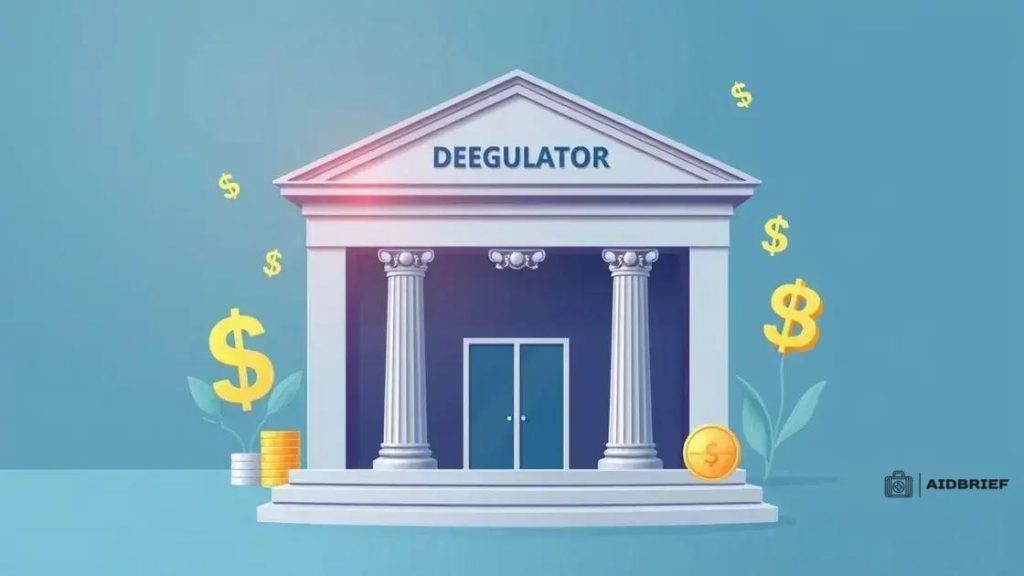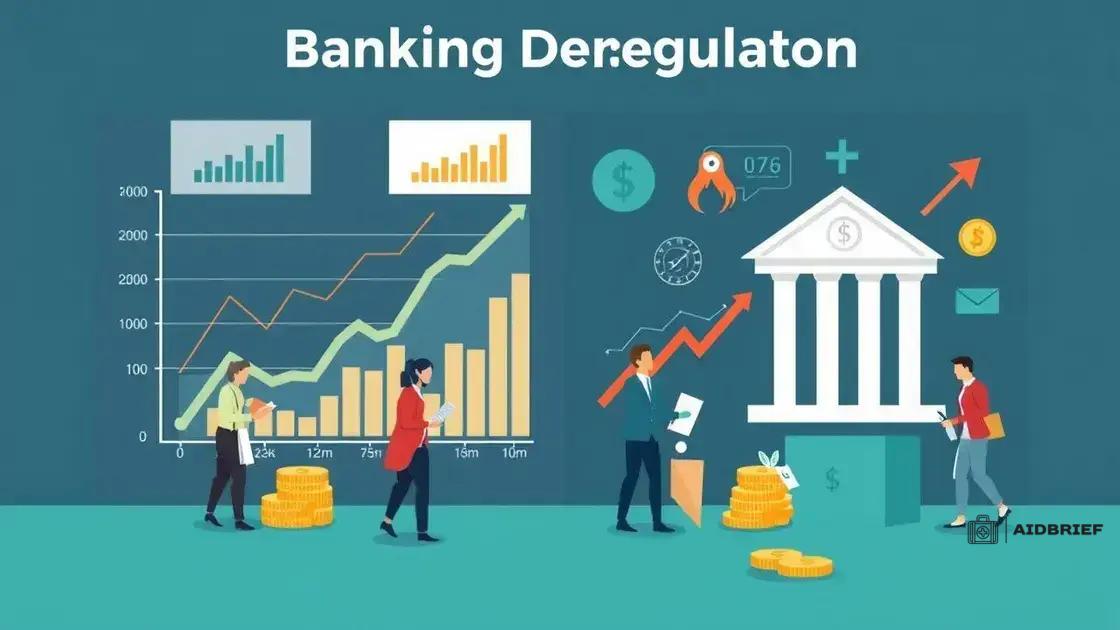Bank deregulation initiatives under Trump: what changes occurred?

Bank deregulation initiatives under Trump aimed to enhance economic growth by loosening restrictions on banks, increasing lending, and encouraging competition, but raised significant concerns about consumer protection and financial stability.
Bank deregulation initiatives under Trump have sparked significant changes in the financial sector. Curious about how these shifts affect you and the economy? Let’s dive into the details.
Understanding bank deregulation
Understanding bank deregulation is essential in today’s financial landscape. It involves relaxing the rules that banks must follow. This change aims to foster competition and innovation in the banking sector. However, it also raises important questions about safety and accountability.
What is bank deregulation?
Bank deregulation refers to the process of removing government restrictions on financial institutions. It allows banks greater freedom in how they operate. For instance, banks can offer more diverse products and services without stringent oversight.
Key reasons for bank deregulation
Several reasons drive the push for bank deregulation:
- Encouraging competition among banks.
- Fostering financial innovation.
- Reducing barriers for new banks entering the market.
- Enhancing consumer choice.
While these reasons sound beneficial, they have led to challenges. For example, when banks operate with fewer restrictions, they may take on riskier investments that could threaten the economy. It’s a balancing act that regulators must navigate carefully.
As we explore the effects of deregulation, it’s crucial to think about the responsibilities banks have towards their customers. Sound risk management is vital to protect both consumers and the broader financial system. By reducing oversight, banks might prioritize profit over stability, leading to potential crises in the future.
Overall, understanding bank deregulation helps us see the changes in financial dynamics. Awareness of these changes can empower consumers to make informed decisions in a complex economic environment.
Key initiatives introduced by Trump
The key initiatives introduced by Trump aimed to reshape the banking landscape in significant ways. One of the primary goals was to boost economic growth by loosening regulations that many believed hampered banks’ ability to lend.
Major deregulation policies
Several notable policies emerged from the Trump administration:
- The repeal of parts of the Dodd-Frank Act.
- Relaxation of capital requirements for smaller banks.
- Expansion of options for bank mergers and acquisitions.
- Increased accessibility for fintech companies.
By targeting these areas, the government hoped to enhance financial services and stimulate competition. This included easing restrictions on community banks, making it easier for smaller institutions to thrive.
Additionally, Trump emphasized the need for a regulatory environment that encourages innovation. This was particularly aimed at fintech startups, which have emerged as disruptive forces in the financial industry. By removing barriers, these companies can offer new products that challenge traditional banking methods.
While these initiatives sparked debate, supporters argued that they would lead to more loans for consumers and businesses. However, critics raised concerns about the potential risks associated with less oversight. They feared that reducing regulations might lead to reckless practices similar to those seen before the 2008 financial crisis.
As the industry adapted to these initiatives, the long-term consequences remain a topic of discussion. The balancing act between fostering growth and ensuring security continues to evolve, shaping the future of banking.
Economic impact of deregulation

The economic impact of deregulation in the banking sector has been profound. By reducing restrictions, banks gained the ability to lend more freely, which aimed to stimulate growth. Increased lending can lead to more investments in various sectors, including small businesses and housing.
Short-term benefits
Many argue that deregulation brings immediate advantages:
- Increased availability of credit for consumers.
- Lower interest rates due to greater competition.
- Encouragement of entrepreneurial ventures.
- Boosted overall economic growth.
These benefits can create a ripple effect throughout the economy, leading to job creation and higher consumer spending. As banks expand their lending capabilities, they can help fuel various economic initiatives.
Long-term risks
However, the long-term effects of deregulation warrant caution. With increased lending comes the risk of defaults, especially if borrowers cannot meet their obligations. The 2008 financial crisis exemplified how easy access to credit without proper oversight can lead to catastrophic failures.
Moreover, as banks pursue profit, they might engage in riskier investments, potentially destabilizing the financial system. Striking a balance between helping the economy grow and maintaining financial stability is essential. Monitoring this balance is critical to avoid a situation where rapid growth leads to another crisis.
Understanding the full scope of the economic impact of deregulation helps consumers and policymakers navigate the complexities of a changing financial landscape. Ongoing discussions around regulation continue to shape the future of the banking industry.
Public response and concerns
The public response and concerns regarding bank deregulation have varied widely. Some people welcome the changes, believing they promote economic growth and innovation. Others express worry over potential negative consequences for consumer protection and financial stability.
Support for deregulation
Many supporters of deregulation argue that loosening restrictions allows banks to operate more efficiently. They highlight key benefits:
- Greater access to credit for individuals and businesses.
- Lower interest rates resulting from increased competition.
- Enhanced customer service as banks strive to win clients.
- Opportunities for startups and fintech companies to enter the market.
This optimism stems from the belief that a freer banking environment encourages growth and innovation. Many see it as a necessary step to keep the U.S. economy competitive.
Concerns and criticisms
However, significant concerns have been raised. Critics argue that deregulation could lead to reckless behavior by financial institutions. Some of the biggest worries include:
- Increased risk of financial crises due to inadequate oversight.
- Potential harm to consumers facing predatory lending practices.
- Loss of protections put in place after the 2008 financial crisis.
- Systemic risks that could affect the entire economy.
These concerns have sparked heated debates among policymakers and the public. Many fear that the pursuit of profit could overshadow the need for responsible banking practices.
Overall, the public response illustrates a deep divide regarding the future of banking regulations. Understanding these perspectives is crucial for navigating the complexities of financial policy and making informed decisions.
Future of banking regulations
The future of banking regulations is a topic of great importance as financial landscapes evolve. As economies shift and technology advances, regulations must adapt to ensure stability and growth. Policymakers face the challenge of balancing innovation with consumer protection.
Emerging trends
Several trends are influencing the future of banking regulations:
- The rise of fintech companies which challenge traditional banks.
- The increasing use of blockchain technology in financial transactions.
- Heightened focus on consumer privacy and data protection.
- A shift towards more transparent banking practices.
These trends require regulators to rethink existing frameworks. For instance, the rapid growth of fintech has drawn attention to the need for updated guidelines that address new business models and technologies.
The importance of flexibility
Flexibility in regulations will be crucial moving forward. As financial environments shift, regulations that can adapt quickly will help maintain stability. This approach can foster innovation while protecting consumers from potential risks.
Additionally, international cooperation will play a key role. As global markets become more interconnected, harmonizing regulations across borders will be necessary to manage risks more effectively.
Legislators will have to anticipate potential challenges, such as the emergence of new technologies and unforeseen market reactions. Ensuring that regulations do not stifle innovation while promoting a stable financial system will be a continuing struggle.
Ultimately, the future of banking regulations will depend on a collective effort among regulators, industry leaders, and consumers. Understanding these dynamics will help shape a financial landscape that balances growth and security.
The conclusion brings together the key insights from our discussion on bank deregulation initiatives under Trump. While deregulation aims to foster economic growth, it also raises concerns about consumer protection and financial stability. Balancing these interests is crucial as we look to the future of banking regulations. Ongoing conversations about innovation, risk, and flexibility will help shape a banking system that serves both the economy and the public effectively.
FAQ – Questions About Bank Deregulation Initiatives Under Trump
What are the main goals of bank deregulation?
The main goals include promoting economic growth, increasing lending, and fostering competition among financial institutions.
What are the potential risks associated with deregulation?
Potential risks include reduced consumer protections, increased chances of financial crises, and irresponsible banking practices.
How does deregulation affect consumers?
Deregulation can provide consumers with more access to credit and lower interest rates, but it may also expose them to predatory lending practices.
What should we expect in the future of banking regulations?
The future may include flexible regulations that adapt to technological advancements, aimed at balancing innovation with consumer protection.





